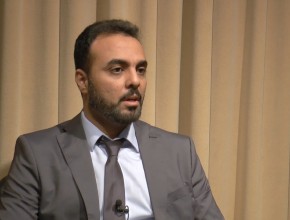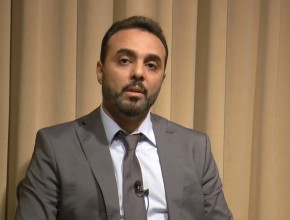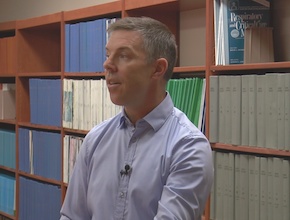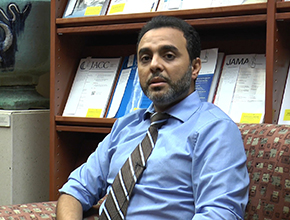References
Rhodes A, Evans LE, Alhazzani W, et al. Surviving Sepsis Campaign: International Guidelines for Management of Sepsis and Septic Shock: 2016. Crit Care Med. 2017 Jan 17. doi: 10.1097/CCM.0000000000002255. [Epub ahead of print] PubMed PMID: 28098591.This video is part of a special 6-episode series of McMaster Perspective focusing on Surviving Sepsis Campaign 2016 guidelines.
Roman Jaeschke: Welcome to another edition of McMaster Perspective. We are continuing the Surviving Sepsis Campaign discussion. Doctor Waleed Alhazzani is still with us – the methodology chair of those guidelines. I would like to talk about another part of the guidelines dealing with diagnosis. The issue here is timing of cultures. Maybe we can expand a little bit on that.
Waleed Alhazzani: The way the guideline stands now is it recommends doing cultures, especially blood cultures, within the first 45 minutes, and not to delay antibiotics if there will be delays in getting cultures. For some patients it will be easy to get blood cultures, and for other patients it will be hard to obtain blood cultures and further methods are needed. In these scenarios, you probably should not be delaying antibiotics. The reason to restrict the timing to the first 45 minutes is because we recommended giving antibiotics as early as possible within the first hour, just to make the guideline consistent, and this is the whole rationale behind it: we have the first 45 minutes to allow physicians to order cultures, or nurses, or whoever is taking the blood cultures, to do that within the first 45 minutes. It is, again, to highlight the importance of these simple interventions: giving antibiotics early, doing cultures to capture the culprit organism. They are important and easily forgettable.
RJ: And giving fluids along the way?
WA: Of course. That is separate from the diagnosis strategy, but yes, fluids as well are important. Again, this is specific to your question about diagnosis and cultures. This is the whole rationale behind doing this.
RJ: [...] I will go to the next section, which is on antimicrobial therapy. You mentioned giving antibiotics within 1 hour. How easy, how feasible is it?
WA: Again, excellent question. This was also a subject of a lot of discussion within the panel. Although it may sound easy to say to give antibiotics within the first hour, the reason for setting that threshold is based on observational studies that show that each hour of delay in giving antibiotics is associated with an 8% increase in mortality in septic patients. Again, to highlight the importance of giving antibiotics early, we were consistent with the older recommendation by saying give antibiotics within the first hour. However, in reality we do not know if giving antibiotics in the first hour compared to giving them within the first hour and a half or 2 hours makes a whole lot of difference. But again, it is to highlight the importance of the need to recognize this disease, intervene quickly, initiate resuscitation, and try to obtain antibiotics as soon as possible.
RJ: You mention the 8% difference. It is 8 more people potentially dead out of 100 who are getting antibiotics later rather than sooner.
WA: Yes.
RJ: So it is an incredible amount of effect. Let’s keep talking about antibiotic delivery. I see several statements as recommendations or as text talking about achieving high levels of antimicrobial activity fast. How could that be done?
WA: That is an excellent question too. You are referring to the best-practice statement we issued on pharmacokinetics and pharmacodynamics to optimize those when delivering antibiotics to septic patients. Again, this was a contentious recommendation. A lot of discussion happened within the panel with input from our colleagues, infectious disease experts, and the reason we left it vague [is because] the scope of going into more details about specific antibiotics and deliveries is probably out of the scope of this resuscitation guideline for septic patients. Maybe in the future there should be a specific guideline addressing those specific recommendations. There are a few examples throughout the discussion that are worth going through. The whole idea is to optimize the first dose by giving maybe the full dose or even higher doses in some patients just to ensure that...
RJ: Higher initial doses?
WA: Yes, higher initial doses to ensure you achieve high levels in the blood and achieve infection eradication quicker. Also, things like frequency of dosing specific to beta-lactams, fluoroquinolones, and how much you should give them, should you increase the dose, should you increase the frequency – all those details. Although this was a best-practice statement, just to highlight that it is important to take these considerations [into account] – which we do in our practice sometimes – but we thought this is an important message to deliver out for clinicians who are treating septic patients to be aware and always thinking about not only giving antibiotics early, but how can we ensure that those antibiotics are delivered at an appropriate context, dosing, and delivering method.
RJ: There seems to be a clear shift in the emphasis in this particular section to give it not only fast, which was there before, but probably err on giving higher doses and faster infusions, at least to start with. Thank you for this. Talking about antibiotic delivery, there were a few labels including broad-spectrum, combination, and multidrug therapy, which may be worth explaining.
WA: Absolutely. These are important distinctions. I advise anyone – including myself – who is going to read the guidelines to go through the table that illustrates these differences and the definitions, because if you are not familiar with this terminology, it might mean something different in your mind to what it actually means in the recommendation. We will start with a combination therapy, which simply means more than 1 drug targeting a single organism, for example, pneumococcal or Escherichia coli sepsis; [it is] using more than one agent from 2 different classes to target a single organism.
RJ: So that is clearly new?
WA: Yes. This is new in this guideline and we can talk about why and what did we address, but I want to go through the definitions first and then we will address why and what did we say exactly about those definitions. Empiric coverage, as the name implies, is starting antibiotics empirically before your know what the causative agents are, based on your best clinical judgement and what you think the organism would be. Multidrug therapy or broad-spectrum therapy: when you want to cover someone empirically, use broad-spectrum coverage to cover all the possible organisms. It is different from combination therapy, where you try to use 2 different classes of antibiotics to target a specific organism; here you may use different agents to cover more than 1 possible organism.
RJ: Again, choosing to use 2 antibiotics to cover 1 organism, which is the combination therapy, is a new concept introduced in those particular guidelines. Which patients should it apply to? Anybody with infection?
WA: That is an excellent question. I will step back a bit and talk about the rationale for this specific recommendation. What we said is that patients who have septic shock, patients who are sick, the extremely sick patients with septic shock probably will benefit from having combination therapy. Therefore, we issued a weak recommendation for using combination therapy in patients with septic shock. However, in patients who have sepsis, it seems that the benefit is not as pronounced as in the septic shock patients. Therefore, we suggested not to use combination therapy in patients with sepsis, and to be honest, this is mostly based – especially the septic shock group – on observational studies; very low-quality data that showed that the higher the mortality rate in these patients – in these observational studies, obviously – the more the benefit from giving combination therapy to target a single organism. I truly think that this is an area of future research and more studies are needed before we say everybody should be getting combination therapy in this category, but the general belief across the panel members and after a lot of discussion, weighing in the benefits of giving combination therapy and the downsides – like causing Clostridium difficile for example, increasing resistance down the road with multiple agents – was slightly in favor of saving lives and giving combination therapy. Also, we say you have to de-escalate once the patient improves quickly, so there is an initiation phase, and you always have to assess your antibiotics, not just keep them for the full course of treatment. The physiological idea is to eradicate the organism and to have the killing capacity early on.
RJ: Maybe we will finish this section of McMaster Perspective with a question. You mentioned the phrases “sepsis” and “septic shock.” How were you defining those? We know about the new suggested definitions.
WA: In this specific guideline, we tried to be consistent with the new Sepsis-3 definition that came out in 2016. However, almost all the studies that we used to support the evidence for the recommendations were based on the previous definition, so there is some sort of indirectness. You will notice that the term “severe sepsis” was used in very few situations, where we described the original studies that used this population, but for the purpose of this guideline we used “sepsis,” which indicates the presence of infection and organ damage or septic shock in patients who despite aggressive fluid resuscitation or appropriate fluid resuscitation have high lactate levels and require vasopressors. This just to be consistent with the new definition.
RJ: Thank you. Thank you very much. We will come back to sepsis.
 English
English
 Español
Español
 українська
українська





